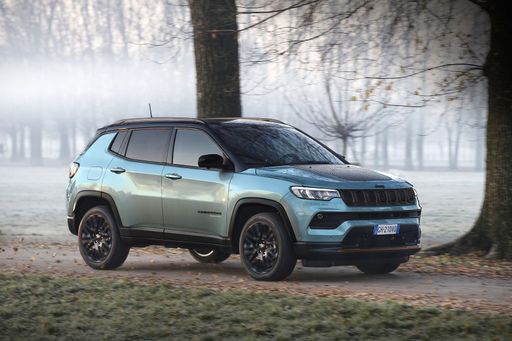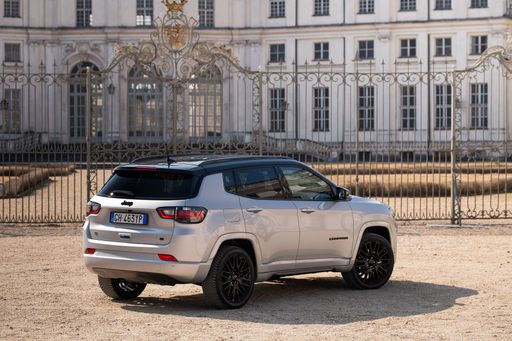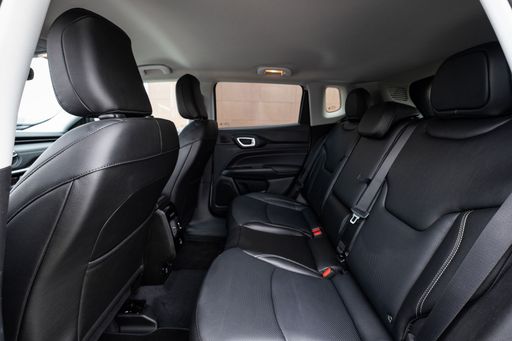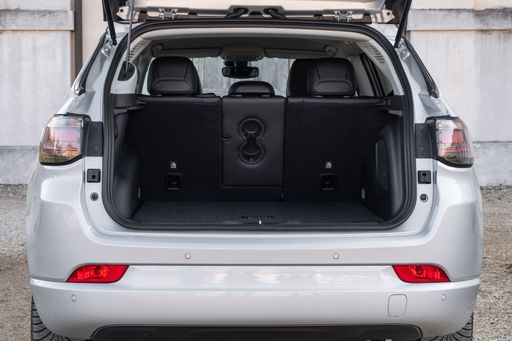Jeep Compass vs Maxus eTERRON 9 – Differences & prices compared
Compare performance, boot space, consumption and price in one view.
Find out now: which car is the better choice for you – Jeep Compass or Maxus eTERRON 9?
The Jeep Compass (SUV) comes with a Petrol MHEV, Plugin Hybrid or Electric engine and Automatic transmission. In comparison, the Maxus eTERRON 9 (Pickup) features a Electric engine with Automatic transmission.
When it comes to boot capacity, the Jeep Compass offers 550 L, while the Maxus eTERRON 9 provides – depending on how much space you need. If you’re looking for more power, decide whether the 240 HP of the Jeep Compass or the 442 HP of the Maxus eTERRON 9 suits your needs better.
In terms of consumption, the values are 17.50 kWh2 L per 100 km for the Jeep Compass, and 26.70 kWh for the Maxus eTERRON 9.
Price-wise, the Jeep Compass starts at 34200 £, while the Maxus eTERRON 9 is available from 64200 £. Compare all the details and find out which model fits your lifestyle best!
Jeep Compass
The Jeep Compass combines a rugged aesthetic with modern sophistication, making it a standout choice in the compact SUV segment. Its robust design is complemented by a comfortable interior that offers ample space and cutting-edge technology for a seamless driving experience. Whether tackling urban environments or venturing off-road, the Compass provides versatility and reliability, embodying the adventurous spirit synonymous with the Jeep brand.
details @ media.stellantis.com
@ media.stellantis.com
 @ media.stellantis.com
@ media.stellantis.com
 @ media.stellantis.com
@ media.stellantis.com
 @ media.stellantis.com
@ media.stellantis.com
 @ media.stellantis.com
@ media.stellantis.com
Maxus eTERRON 9
The eTERRON 9 stands out with its striking design and innovative features, making it a compelling choice for eco-conscious drivers. Its spacious interior and advanced technology provide a seamless driving experience that prioritizes both comfort and connectivity. With impressive efficiency and an array of smart capabilities, the eTERRON 9 is redefining what modern electric vehicles can offer.
details

|
|
|
|
|
Costs and Consumption |
|
|---|---|
|
Price
34200 - 46900 £
|
Price
64200 - 66800 £
|
|
Consumption L/100km
2 - 5.9 L
|
Consumption L/100km
-
|
|
Consumption kWh/100km
17.50 kWh
|
Consumption kWh/100km
26.70 kWh
|
|
Electric Range
36 - 500 km
|
Electric Range
430 km
|
|
Battery Capacity
74 kWh
|
Battery Capacity
-
|
|
co2
0 - 133 g/km
|
co2
0 g/km
|
|
Fuel tank capacity
36 - 55 L
|
Fuel tank capacity
-
|
Dimensions and Body |
|
|---|---|
|
Body Type
SUV
|
Body Type
Pickup
|
|
Seats
5
|
Seats
5
|
|
Doors
5
|
Doors
4
|
|
Curb weight
1575 - 2198 kg
|
Curb weight
2925 - 2955 kg
|
|
Trunk capacity
420 - 550 L
|
Trunk capacity
-
|
|
Length
4404 - 4552 mm
|
Length
5500 mm
|
|
Width
1819 mm
|
Width
1997 mm
|
|
Height
1629 - 1675 mm
|
Height
1860 mm
|
|
Payload
465 - 470 kg
|
Payload
545 - 575 kg
|
Engine and Performance |
|
|---|---|
|
Engine Type
Petrol MHEV, Plugin Hybrid, Electric
|
Engine Type
Electric
|
|
Transmission
Automatic
|
Transmission
Automatic
|
|
Transmission Detail
Dual-Clutch Automatic, Automatic Gearbox, Reduction Gearbox
|
Transmission Detail
-
|
|
Drive Type
Front-Wheel Drive, All-Wheel Drive
|
Drive Type
All-Wheel Drive
|
|
Power HP
130 - 240 HP
|
Power HP
442 HP
|
|
Acceleration 0-100km/h
7.3 - 10.3 s
|
Acceleration 0-100km/h
5.80 s
|
|
Max Speed
180 - 200 km/h
|
Max Speed
190 km/h
|
|
Torque
230 - 345 Nm
|
Torque
700 Nm
|
|
Number of Cylinders
4
|
Number of Cylinders
-
|
|
Power kW
96 - 177 kW
|
Power kW
325 kW
|
|
Engine capacity
1199 - 1469 cm3
|
Engine capacity
-
|
General |
|
|---|---|
|
Model Year
2024 - 2025
|
Model Year
2025
|
|
CO2 Efficiency Class
D, B, A
|
CO2 Efficiency Class
A
|
|
Brand
Jeep
|
Brand
Maxus
|
Jeep Compass
Exploring the Jeep Compass: A Modern SUV with Innovative Features
The Jeep Compass continues to challenge the boundaries of what an SUV can be, offering a blend of practicality, efficiency, and rugged appeal. This model, distinguished by its diverse range of powertrains, promises to cater to various needs and preferences. From urban commuting to exploring off-road trails, the Compass delivers with aplomb.
Engine Versatility and Performance
Under the bonnet, the Jeep Compass offers a diverse lineup of engines designed to meet varying driver demands. With options ranging from mild hybrid petrol engines to advanced Plug-in Hybrid Electric Vehicles (PHEVs), the Compass provides both efficiency and power. This impressive engine choice results in power outputs from 130 to 240 PS, ensuring that there is a model suitable for both city driving and more ambitious off-road excursions.
Performance devotees will appreciate the Compass's quick acceleration, clocking 0-100 km/h in as little as 7.3 seconds. Meanwhile, fuel economy remains commendable, with consumption figures between 1.7 to 5.5 litres per 100 kilometres, making the Compass an economical choice for daily driving.
Innovative Hybrid Technology
The Jeep Compass brings cutting-edge hybrid technology to the forefront. The available plug-in hybrid variants offer electric-only driving ranges of up to 53 kilometres, ideal for environmentally conscious urban drivers. This zero-emission capability makes short trips sustainable without compromising on the flexibility offered by the internal combustion engine for longer journeys.
Dynamic Drivetrain Options
One of the main talking points of the Compass is its adaptable drivetrain options, which include both front-wheel drive and all-wheel drive systems. The 4xe PHEV models particularly stand out with their all-wheel drive, providing enhanced stability and traction suitable for varying terrains. Additionally, the automated transmission ensures smooth gear changes and an overall comfortable driving experience.
Design and Comfort
Beyond performance, the Jeep Compass excels in providing a stylish and functional environment. The SUV's dimensions, ranging between 4398 to 4404 mm in length and up to 1874 mm in width, offer ample interior space for both passengers and cargo. The boot space varies from 420 to 438 litres, accommodating the needs of families and adventure-seekers alike.
With seating for five, maximum comfort is assured, thanks to high-quality materials and thoughtfully designed interiors. The Compass integrates advanced technology seamlessly into its cabin, ensuring easy connectivity and an engaging driving experience.
Safety and Efficiency
Safety is paramount in the Jeep Compass, with a range of driver assistance features providing peace of mind. The model adheres to impressive CO2 efficiency standards, boasting a CO2 emission range between 37 and 123 g/km, making it both a responsible and reliable choice.
Furthermore, the Compass offers competitive running costs, with monthly expenses ranging from €1,095 to €1,315, and an average cost per kilometre between 43.8 and 52.6 cents. This cost-effectiveness further underscores the Compass’s value proposition.
Conclusion
Overall, the Jeep Compass stands out as a richly equipped, versatile SUV, ready to tackle urban or off-road challenges. With its blend of powertrain innovations, superior performance, and sophisticated design, it redefines what’s possible in the SUV segment. Whether for efficient city driving or adventurous journeys into the unknown, the Compass is ready to rise to the occasion.
Maxus eTERRON 9
The automotive industry is witnessing a remarkable transformation as electric vehicles (EVs) become more mainstream. One of the standout entrants in this rapidly evolving marketplace is the Maxus eTERRON 9, an electric pickup that combines cutting-edge technology, impressive performance metrics, and an appealing design. This model, tailored for modern consumers and businesses alike, is revolutionizing the way we view utility in an EV format.
Stunning Performance Metrics
The eTERRON 9 is a powerhouse of performance, boasting an impressive 442 horsepower generated by its electric engine. This output allows for exhilarating acceleration, enabling it to go from 0 to 100 km/h in just 5.8 seconds. The automatic transmission paired with the all-wheel-drive system ensures a smooth and dynamic driving experience, making it as adept at navigating city streets as it is on rugged terrain.
Innovative Efficiency
In a world increasingly focused on sustainability, the Maxus eTERRON 9 stands out with its impressive efficiency, consuming only 26.7 kWh per 100 km. This efficiency does not come at the cost of range; the eTERRON 9 is capable of covering up to 430 km on a single charge, making it suitable for both daily commutes and longer journeys. Its CO2 efficiency class of A further highlights its commitment to reducing emissions, with a remarkable 0 g/km CO2 output, ensuring environmentally conscious driving.
Design and Practicality
The exterior dimensions of the eTERRON 9 are quite grand, measuring 5500 mm in length, 1997 mm in width, and 1860 mm in height. This gives the pickup a commanding presence on the road, while also offering a spacious interior. With a seating capacity for five, the cabin is designed for comfort and utility, ensuring that passengers enjoy ample space even on longer trips. The eTERRON 9 also features four doors, thereby maximizing accessibility for all occupants.
Payload and Versatility
One of the eTERRON 9’s standout features is its impressive payload capacity, ranging from 545 to 575 kg, depending on the specification. This makes it an ideal choice for businesses needing a reliable vehicle for transporting goods, as well as for outdoor enthusiasts looking to carry extra gear on their adventures. The combination of electric power and significant payload capacity means that the eTERRON 9 doesn't just perform well—it adapts to a variety of practical situations.
Technological Innovations
The technological suite in the Maxus eTERRON 9 is nothing short of revolutionary. With advanced infotainment systems and connectivity features, drivers can easily access navigation, music, and vehicle diagnostics through intuitive interfaces. Additionally, safety remains a paramount focus, with state-of-the-art driver-assist technologies helping to prevent accidents and enhance overall vehicle control.
Conclusion: The Future of Electric Mobility
The Maxus eTERRON 9 is not just another electric vehicle; it represents a significant step forward in the integration of electric power into traditional utility segments such as trucks and pickups. With a perfect blend of performance, efficiency, design, and technology, the eTERRON 9 stands poised to capture the attention of both daily drivers and commercial enterprises alike. As we move into a more sustainable future, vehicles like the eTERRON 9 will play a crucial role in shaping how we view transportation.
The prices and data displayed are estimates based on German list prices and may vary by country. This information is not legally binding.
